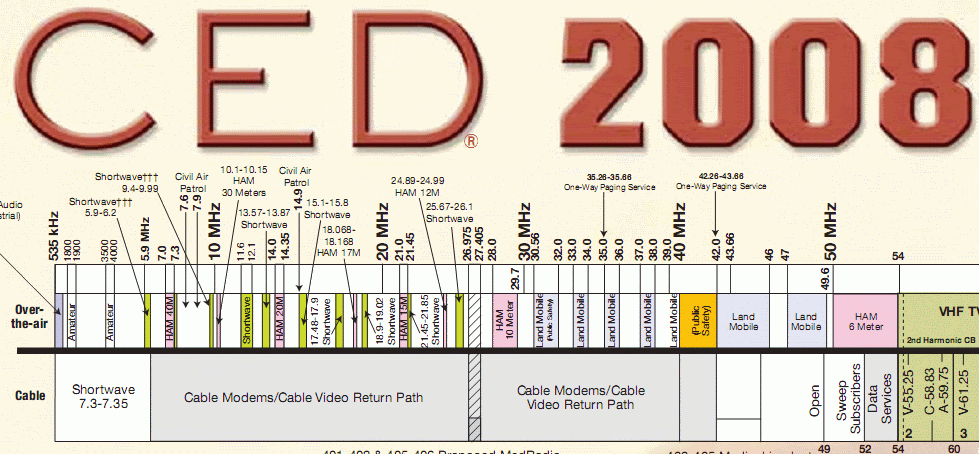A new article in Broadcasting & Cable highlights the American Cable Association’s attempt to sway the FCC via a December 11th letter by the ACA President Matt Polka (in addition to the regular lobbying of cable-related issues through their PAC) to eliminate “Must Carry” rules so that they can “offer Internet speeds as fast as 100 Mbps with minimal upgrades to their existing plants through a process called channel bonding.“
This is nothing short of a “land grab” for Big Cable to kick the broadcasting industry while it’s viewership and revenue is down and use the promise of amazing Internet access speeds (for the extreme minority of subscribers that could afford and/or would like to have it) to free themselves of having to pay local broadcasters for carriage of their content.
Using the CED Magazine Freq Chart as a guide (excerpt below) one can see that current cable modems, which provide the highest Internet access speeds for the average public short of FiOS service from Verizon, only occupy the space between 6MHz and 40MHz (34MHz total) out of the typical 1GHz available to modern CATV deployments. In other words, about 3.4% of their total capacity. Adding the space of another 4 TV channels (24MHz) increases the total cable modem bandwidth usage 58MHz (5.8% of total capacity).
Couple that with these facts:
- The CATV industry’s progressive elimination of their analog tier and deployment of DTAs (Digital Transport Adapters) for those that still only have the basic cable subscription (e.g. many fixed and low-income customers) expands their channel carrying capability using QAM on more expensive subscription tiers.
- A cable headend can easily multiplex 2 full-bitrate broadcast HD channels or over 20 standard definition video channels in a single QAM constellation.
- The ability for cable to add additional Pay-Per-View channel streams on the additional QAM channels it creates by elimination of the analog channels.
- Cable companies (like Comcast) already claim to provide over “1,000 High-Def choices” clearly illustrating that there is no drought of selection with their current offerings and “bandwidth limitations”.
- Internet access rates between $20 and $99 (far more than the average basic cable rate for television) for currently available speeds of up to 50Mbps downstream and 10Mbps upstream.
- The increased opportunity for cable companies to lease modems to its subscribers for additional monthly revenue on top of the Internet access rates it charges.
It is easy to see that there is no down side for the cable industry, win or lose, with this challenge to the FCC. So, why wouldn’t they create a new angle of attack on over-the-air local broadcasters and Must Carry provisions using a manufactured need and bogus bandwidth crisis?
Just don’t fall for the hype.

